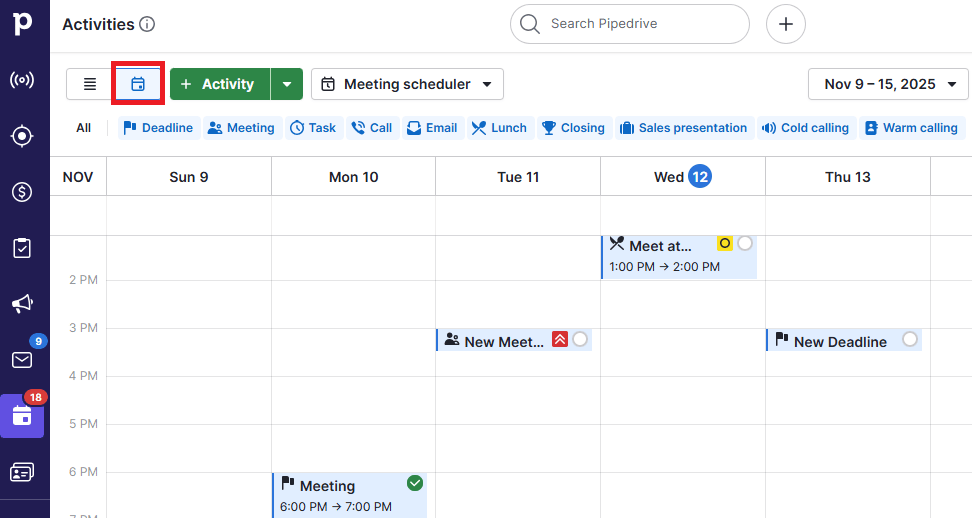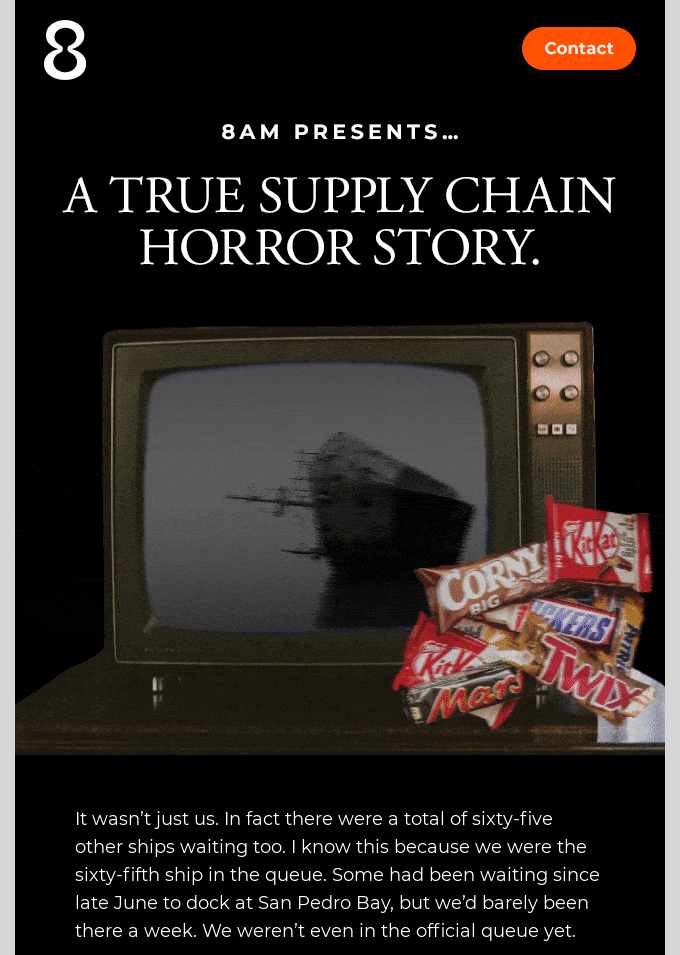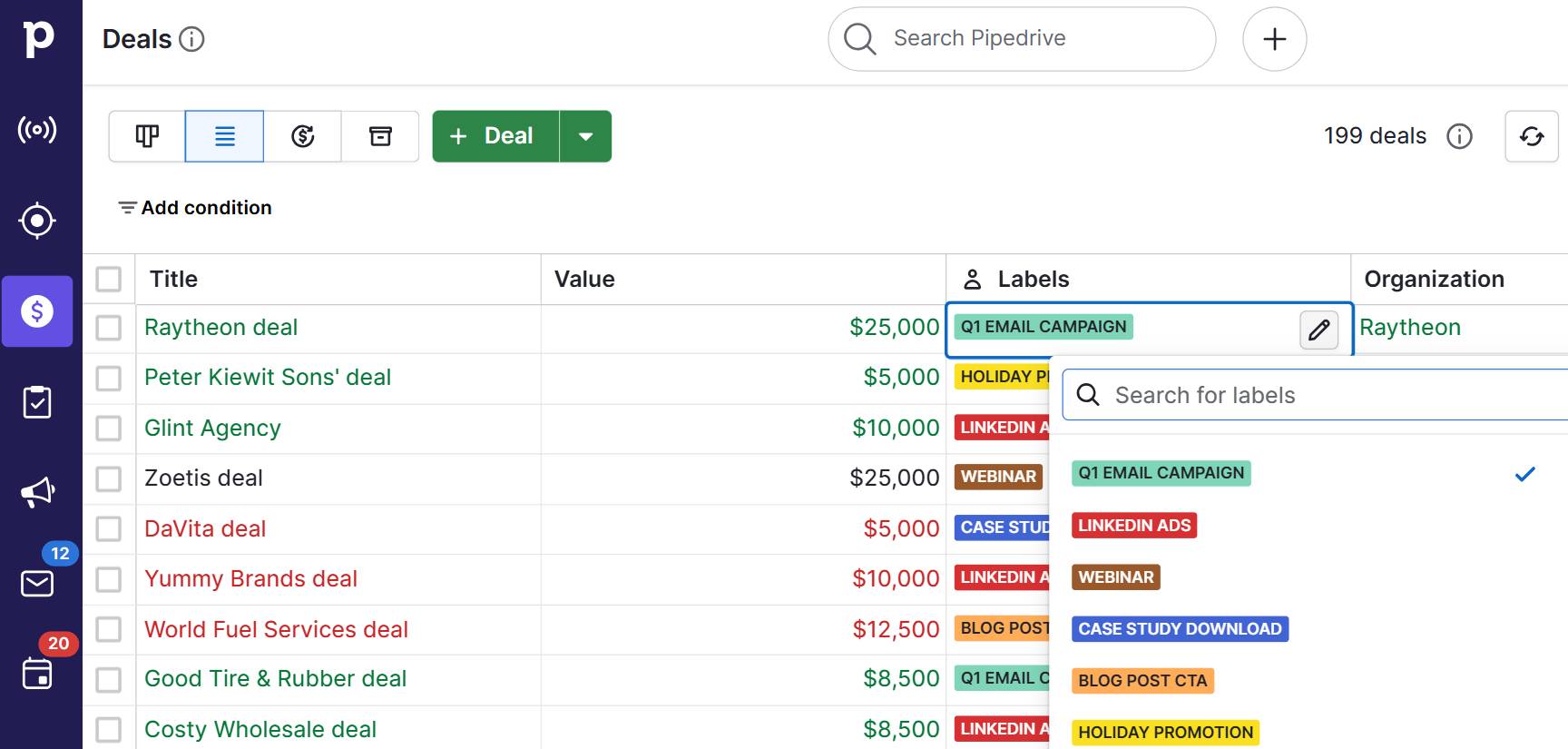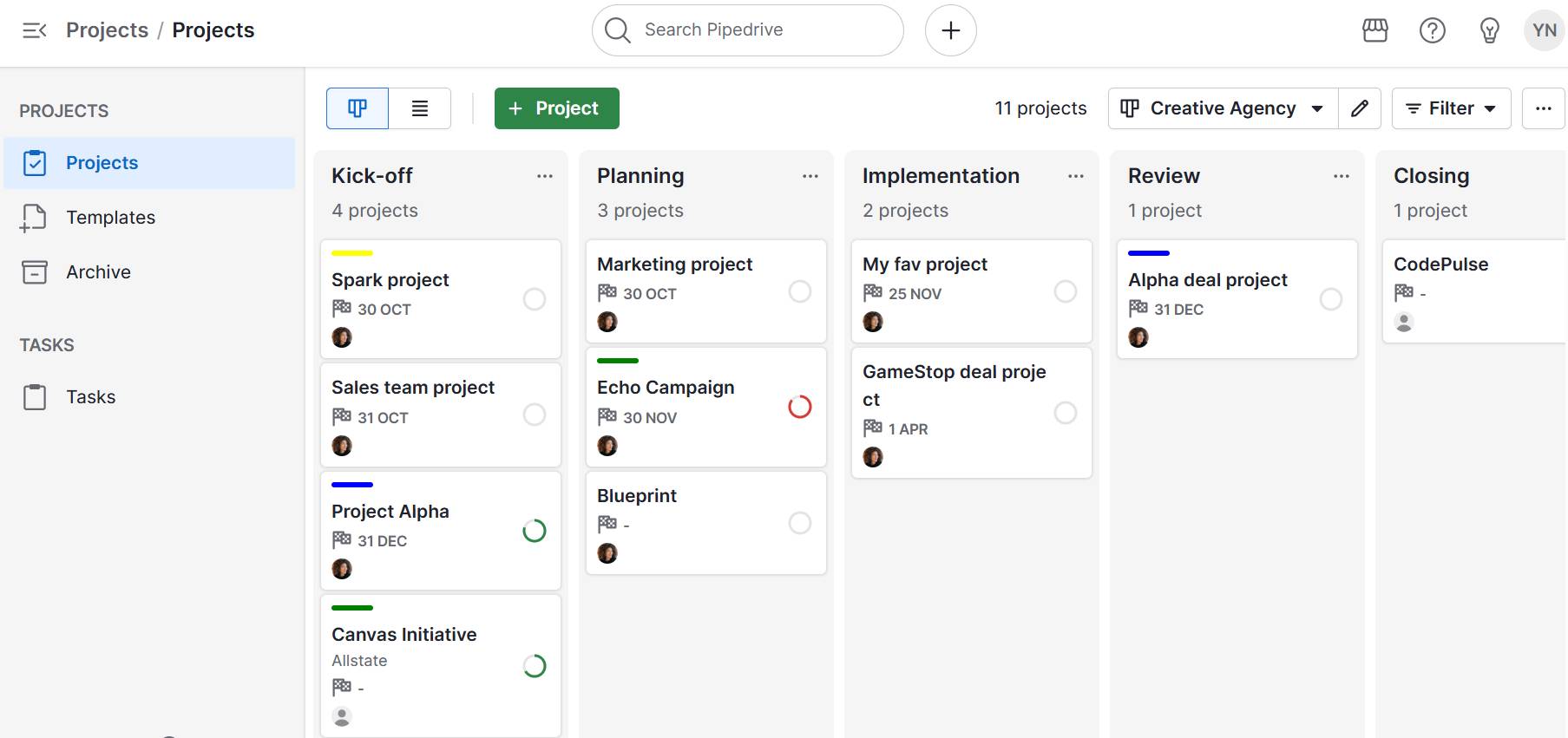Marketing calendars promise order in the chaos of running campaigns and keep initiatives from getting lost in daily tasks. They give you a clear picture of what content goes where, who does what and when deadlines land.
In this article, you’ll learn how to create a marketing calendar and how to connect planning to execution. You’ll get a free template, learn actionable steps to build a calendar that works for small teams and see a complete list of 2026 marketing dates to fill it with.
Key takeaways
A marketing calendar helps you plan campaigns, assign tasks and track execution in one place.
Small marketing teams need calendars that bridge planning and doing, not just planning alone.
The right tool depends on your team size, budget and how much automation you need.
Pipedrive has activity tracking and notifications to keep your marketing calendar tasks visible and on schedule. Try it free for 14 days.
What is a marketing calendar?
A marketing calendar shows all your marketing activities in one view, giving you a framework for planning marketing activities weeks, months or years in advance.
You can see blog posts, email campaigns, social media content, product launches and events mapped against concrete dates.
The calendar helps you:
Spot conflicts before they happen. If three campaigns launch the same week, you’ll see the collision early enough to adjust.
Assign clear ownership. Each task has a name attached, so nothing falls through the cracks.
Track progress toward deadlines. You’ll know exactly which campaigns are on schedule and which ones need attention.
Make data-driven decisions. When you see everything in one place, you can prioritize based on what will have the most impact.
The most effective marketing calendars bridge the gap between planning and doing. They not only show what you want to create, but also help you track each step until campaigns go live.
Free marketing calendar template
Download our free marketing calendar 2026 template to get started right away. The template includes:
Pre-built columns for campaign name, channel, owner, status and deadline
Space to track marketing metrics and KPIs like traffic, leads or conversions
Get your free internal marketing calendar template (Google Sheets or Excel)
The sample marketing calendar template is compatible with Google Sheets or Excel. Make a copy and customize it based on your team’s marketing channels, campaign types and reporting needs.
How to create a marketing calendar you’ll actually use
A helpful marketing calendar doesn’t just have due dates – it connects planning to execution by tracking who does what and when.
Follow these steps to create a marketing calendar that helps you plan, organize and follow through.
1. Define your goals
Start by identifying what you want marketing to achieve this year.
Setting goals gives you clear criteria for what should go on your calendar this quarter and what can wait.
For example, common digital marketing goals include:
Brand awareness. Increase website traffic, social media followers or search visibility.
Lead generation. Drive email signups, demo requests or trial activations.
Customer retention. Keep existing customers engaged with newsletters, product updates or loyalty campaigns.
Product launches. Build anticipation and drive early adoption for new features or offerings.
Align your calendar with business goals. If your company plans to launch a new service in Q2, marketing campaigns should build momentum leading up to that date.
Ask your leadership team or department heads what matters most this year and structure your marketing plan around those milestones.
2. Choose content types and publishing frequency
Decide which content formats make sense for your target audience and how often you can publish.
Think about content deliverables like:
Blog posts that answer customer questions, explain product features or share industry insights
Social media campaigns that drive engagement, share news or amplify blog content
Email campaigns for product announcements, lead nurturing sequences or monthly newsletters
Videos or webinars that demonstrate product use cases or build thought leadership
Case studies that showcase customer success and build trust with prospects
Pick a realistic publishing cadence for each channel. A small team might publish one blog post per week, send two email campaigns per month and post on social media three times per week.
Tip: Factor in seasonal or trending topics where they make sense. For example, a SaaS project management tool might create webinar content tied to productivity trends at the start of each year.
3. Pick the right tool
Your calendar tool should match your team’s size, budget and need for automation.
The right choice depends on whether you need simple visibility or deeper integration with task management and tracking.
Here’s a comparison of some of the most popular content calendar and marketing campaign calendar tools.
Spreadsheets (Google Sheets, Excel)
Spreadsheets work well for solo marketers or small businesses who want a free, flexible option.
Strengths | Limitations |
|
|
Project management or CRM software (Pipedrive)
Project management tools or CRMs offer more structure and automation for teams that need task tracking and accountability.
Strengths | Limitations |
|
|
Content management tools (Buffer, Hootsuite)
Content management tools work best for teams that spend most of their time creating and scheduling posts across multiple channels.
Strengths | Limitations |
|
|
Pipedrive brings marketing tools, sales activities and customer data together in one place. You can plan and track your email marketing calendar with the Campaigns add-on, manage follow-up tasks and link every activity to deals and contacts.
A centralized system gives teams a clear view of how marketing efforts move leads through the pipeline and contribute to revenue, without switching between tools.
4. Populate your marketing calendar software with campaigns and deadlines
Once you’ve chosen your tool, add each campaign to your calendar with start dates, end dates and publishing deadlines.
Break larger campaigns into smaller tasks so you can track progress at each stage. For a product launch email campaign, your steps might include:
Draft email copy
Design email template
Set up email automation sequence
Review and approve final draft
Schedule send date
Monitor performance metrics and report results
Assign start dates, end dates and publishing deadlines for each step. If you want to send an email campaign on March 15, work backward to determine when drafts, reviews and approvals must happen.
Include recurring campaigns alongside one-off events in your calendar. Everything should appear on the same calendar so you can see the full picture of what’s happening.
Example: A logistics consulting firm might plan three LinkedIn posts a week, a bi-weekly podcast, a quarterly case study and a one-time webinar tied to an industry conference in June.
Seeing all four activities on the same calendar prevents scheduling conflicts and helps the team allocate resources.
5. Assign tasks and track execution
Every task needs clear ownership to stop campaigns from stalling.
In Pipedrive, you can assign the relevant stakeholders to each activity. In the calendar view, each person can see exactly what they’re responsible for and what’s coming up next.

Use comments, checklists and notifications in your workflows to keep everyone accountable.
When someone finishes a draft, tag the reviewer so they know it’s ready. When a deadline approaches, send a reminder so nothing slips through the cracks.
Pipedrive in action: Chicago-based digital marketing agency SoMe Connect used Pipedrive to centralize campaign planning and client management.
With all outreach, follow-ups and deadlines tracked in one shared view, the team halved its sales cycle and increased revenue by 133%.
The same centralized structure can help small marketing teams manage content calendars, assign ownership and keep campaigns on schedule.
6. Stay flexible and adapt to changes
In small businesses, priorities can shift quickly, so leave room for flexibility in your marketing management.
Add buffer time to your calendar for last-minute campaigns or trending topics. If an industry news story breaks, you want room to create timely content without derailing everything else.
Adjust priorities when team bandwidth changes. If someone leaves the company or takes on a major project, scale back the number of campaigns rather than trying to maintain an unrealistic schedule.
Key dates and holidays for your 2026 marketing campaign calendar
Use this list of important US marketing dates and holidays to plan campaigns throughout the year.
January 2026
January 1 – New Year’s Day
January 19 – Martin Luther King Jr. Day
January 28 – Data Privacy Day
February 2026
February 2 – Groundhog Day
February 14 – Valentine’s Day
February 16 – Presidents’ Day
March 2026
March 8 – International Women’s Day
March 17 – St. Patrick’s Day
March 20 – First Day of Spring
April 2026
April 1 – April Fools’ Day
April 22 – Earth Day
May 2026
May 4 – Star Wars Day
May 10 – Mother’s Day
May 25 – Memorial Day
June 2026
June 21 – Father’s Day
June 21 – First Day of Summer
July 2026
July 4 – Independence Day
August 2026
August 26 – National Dog Day
September 2026
September 7 – Labor Day
September 22 – First Day of Fall
October 2026
October 12 – Columbus Day / Indigenous Peoples’ Day
October 31 – Halloween
November 2026
November 11 – Veterans Day
November 26 – Thanksgiving
November 27 – Black Friday
November 30 – Cyber Monday
December 2026
December 21 – First Day of Winter
December 24 – Christmas Eve
December 25 – Christmas Day
December 31 – New Year’s Eve
Don’t feel like every date needs a campaign. Pick the holidays that matter to your audience and align with your brand.
For example, brand and content strategy agency 8 AM Creative uses seasonal moments to connect with their audience.
For Halloween, they sent an email with a fictional “supply chain horror story” about a cargo ship carrying a shipment of candy bars.

Then, for Thanksgiving, they published a satirical “perfect Thanksgiving speech” blog post filled with dark humor and mad-lib style personalization.

Rather than forcing campaigns around every holiday, the agency focuses on dates where they can create content that resonates with their creative audience.
Making a marketing calendar work for small teams
Small teams can get outsized results from marketing calendars with the right approach.
These strategies help you maximize impact with limited resources while keeping your team energized and focused.
Prioritize campaigns based on impact and resources
Look at past performance data to identify which channels and content types generate the most leads, traffic or revenue.
Intensify efforts around what works and cut or reduce what doesn’t.
In Pipedrive, you can add custom labels to deals depending on which marketing initiatives they came from.

The labels let you see at a glance which campaigns drive the most deals so you know where to focus your marketing efforts.
For example: A financial consulting firm might discover that case studies drive significantly more qualified leads than social media posts. It can shift resources toward creating one high-quality case study per month, rather than on posting daily to multiple platforms.
Repurpose content across channels when possible
Turn one piece of content into multiple assets to optimize your time and ensure your best ideas reach people across different marketing channels.
A single blog post can become:
A series of social media posts highlighting key takeaways
An email newsletter section with a link to the full article
A short video or infographic summarizing the main points
A slide deck for a webinar or presentation
This content marketing strategy will help you fill your calendar fast without having to come up with lots of new ideas.
Keep updates and communication in one place
Scattered conversations across email, Slack and project management tools create confusion.
Pick one place for calendar updates and make sure everyone knows where to look.
Pipedrive’s project management software lets you assign campaign tasks to team members and streamline campaign-related activities and discussions.

When everything lives in one system, you spend less time tracking down information on different dashboards and more time on execution.
Tip: Pipedrive integrates with tools like ActiveCampaign, Zapier and Google Ads Lead Forms to connect marketing data across platforms.
Schedule regular meetings to check on marketing progress
A short weekly meeting keeps everyone aligned without becoming a time sink.
A 15-minute standup is enough to catch problems early and adjust priorities before they become emergencies. Aim to:
Cover what shipped last week
Confirm what’s due this week
Flag any blockers that need attention
Keep the meeting focused by reviewing your calendar during the call. When everyone can see the same view of what’s planned and what’s in progress, you can keep discussions concrete and make decisions faster.
Final thoughts
A marketing calendar that connects planning to execution helps you ship campaigns consistently while keeping your team aligned on priorities.
Define clear goals and set a realistic publishing cadence that matches your bandwidth. Choose a tool that supports both planning and follow-through, then break each campaign into actionable tasks with clear owners.
Try Pipedrive free for 14 days to track marketing activities and keep your team moving forward without the need for constant manual check-ins.






